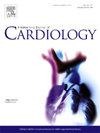急性冠脉综合征患者PCI术后无血流现象的预测模型:系统综述。
IF 3.2
2区 医学
Q2 CARDIAC & CARDIOVASCULAR SYSTEMS
引用次数: 0
摘要
目的:综合评价急性冠脉综合征(ACS)患者经皮冠状动脉介入治疗(PCI)后无血流流现象(NRP)的现有预测模型。方法:系统检索PubMed、Web of Science、Embase、Cochrane Library、Scopus、中国知网(CNKI)、万方数据库、维普(VIP)、中国生物医学文献服务系统(Sinomed),检索截至2024年5月28日ACS患者PCI术后NRP预测模型的相关研究。进行定性综合以评估研究特征和模型特征。结果:共检索到3738篇研究,最终纳入21篇研究,涉及25种预测模型。报告的NRP发生率为3.58 %至33.3% %。大多数模型采用logistic回归,曲线下面积(AUC)在0.637 ~ 0.958之间。模型中经常报道的预测因子包括Killip分类、症状到球囊时间、总缺血时间和pci前TIMI血栓等级等。所有纳入的研究都被评估为具有高偏倚风险(ROB),主要是由于不适当的数据来源和分析领域的方法限制。结论:目前ACS患者PCI术后NRP的预测模型显示出较高的ROB,尚未得到充分验证。目前尚无适合临床决策的预测模型。未来的研究应采用更严谨的方法,强调多中心外部验证,以提高模型的可靠性和适用性。本文章由计算机程序翻译,如有差异,请以英文原文为准。
Prediction models for no-reflow phenomenon after PCI in acute coronary syndrome patients: A systematic review
Objective
To comprehensively evaluate existing prediction models for the no-reflow phenomenon (NRP) after percutaneous coronary intervention (PCI) in patients with acute coronary syndrome (ACS).
Methods
A systematic search was conducted across PubMed, Web of Science, Embase, Cochrane Library, Scopus, China National Knowledge Infrastructure (CNKI), Wanfang Database, Weipu (VIP), and the Chinese Biomedical Literature Service System (Sinomed) up until May 28, 2024, to identify studies on prediction models for the NRP in ACS patients after PCI. A qualitative synthesis was performed to assess study characteristics and model features.
Results
A total of 3738 studies were retrieved, and 21 studies involving 25 prediction models were finally included. The reported incidence of NRP ranged from 3.58 % to 33.3 %. Most models were developed using logistic regression, with area under the curve (AUC) ranged from 0.637 to 0.958. Frequently reported predictors across models included Killip classification, symptom-to-balloon time, total ischemic time, and pre-PCI TIMI thrombus grade, among others. All included studies were assessed as having a high risk of bias (ROB), mainly due to inappropriate data sources and methodological limitations in the analysis domain.
Conclusions
Current prediction models for NRP after PCI in ACS patients exhibit high ROB and have not been adequately validated. Currently, no suitable prediction models are recommended for clinical decision-making. Future research should adopt more rigorous methodologies and emphasize multicenter external validation to enhance model reliability and applicability.
求助全文
通过发布文献求助,成功后即可免费获取论文全文。
去求助
来源期刊

International journal of cardiology
医学-心血管系统
CiteScore
6.80
自引率
5.70%
发文量
758
审稿时长
44 days
期刊介绍:
The International Journal of Cardiology is devoted to cardiology in the broadest sense. Both basic research and clinical papers can be submitted. The journal serves the interest of both practicing clinicians and researchers.
In addition to original papers, we are launching a range of new manuscript types, including Consensus and Position Papers, Systematic Reviews, Meta-analyses, and Short communications. Case reports are no longer acceptable. Controversial techniques, issues on health policy and social medicine are discussed and serve as useful tools for encouraging debate.
 求助内容:
求助内容: 应助结果提醒方式:
应助结果提醒方式:


